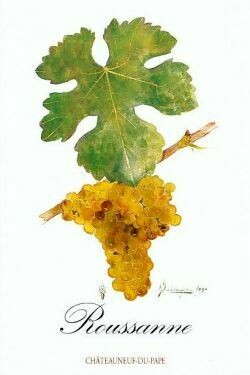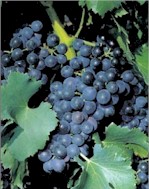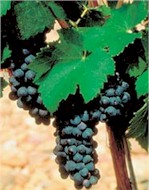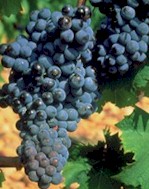Grenache is without competion the most
used grape variety in Chateauneuf du Pape. More than 70% of the vines today are
Grenache. This has not always been the case. If you look at what Joseph Ducos
planted in 1880 it was "Giving
liquor, heat and the marrowy:
Grenache
and Cinsault
in the maximum proportion of two tenth". 100 years later Grenache was
planted on 80% of the fields. On every estate in Chateauneuf du Pape this grape
is planted in more than 50% of the field and some of the estates make wine only
from this grape. If the Grenache plant is young it can be difficult to make
wines with enough colour and structure but it will always bring much alcohol to
the wine because of the high level of sugar in the grapes.
To make great wines from Grenache alone you must have old vines and you must
keep the output at a very low level. Some of the best wines from the appellation
are made from parcels with 60-100 years old Grenache vines and an output of about
20 hl/ha - or less.
Syrah and Mourvedre
are most suitable to blend with Grenache. Both of them bring colour and
structure to the wine.
Syrah reaches its peak in Northern Rhone and brings here (Hermitage, Cote Rotie and
Cornas) very structured wines with a deep colour.
Grenache brings some roundness and elegance to these "hard core"
grapes. The same thing can be said about Mourvedre if you think of the wines from
Bandol, where the Mourvedre wines have the colour and structure like wines from
the Northern Rhone. Both grapes also bring ability to age well to the wines.
Both grapes are planted more and more in Chateauneuf du Pape and this will
probably also be the case in years to come. It's common to see a percentage of
one of them or both in the blend on a level of 15-30%. A leading estate to
promote Mourvedre is Chateau de Beaucastel where the top cuvée has up to 60% of
this grape. You can also see 100% Syrah wine, but such extremities will show a
wine not typical for the appellation.
Cinsault, Counoise, Muscardin,
Vaccarese and
Terret Noir
are planted only on a total of 3,6 ha in the appellation and can't be said to
play a big role. You can meet producers using one of the grapes more than common
and he may claim that this grape give his wines its special character. This may
very well be true. There may perhaps also be some marketing success in claiming
the use of all the 13 grapes.
Clairette, Grenache Blanc,
Bourboulenc, Roussanne, Picpoul and
Picardan are the allowed
varieties for white Chateauneuf du Pape. They cover nearly 7% of the fields and
the white wines are 6-7% of the production. Some of these grapes are used for
the red wines. Picpoul and Picardan are of marginal importance. Most of the
producers make a small amount of white wines and try to sell it at the same prices
as for the red wines. You have to admit that the fame of the appellation doesn't
come from the white wines.
|
|
In 1989 and 2004 was the percentages of the different
varieties in Chateauneuf du Pape:
| Variety |
% 1989 |
% 2004 |
| Grenache |
79,25 |
72,00 |
| Syrah |
5,66 |
10,50 |
| Mourvedre |
4,76 |
7,00 |
| Cinsault |
3,33 |
2,50 |
| Clairette |
2,34 |
2,50 |
| Grenache Blanc |
2,02 |
2,00 |
| Bourboulenc |
1,02 |
1,00 |
| Roussanne |
0,50 |
1,20 |
| Counoise |
0,43 |
0,50 |
| Muscardin |
0,33 |
0,40 |
| Vaccarese |
0,13 |
0,15 |
| Picpoul |
0,11 |
0,15 |
| Picardan |
0,10 |
0,05 |
| Terret Noir |
0,02 |
0,05 |
Source: Federation des Syndicates de Producteurs
de Chateauneuf du Pape.
It's always mentioned that 13 different grapes are used in Chateauneuf du
Pape. In the table above you can count 14. In the rules Grenache Noir and
Grenache Blanc are only counted as one variety. Picpoul can be found as a red variety.
In the rules about pruning is mentioned Grenache Blanc an Picpoul Noir - totally
15 varieties.
It's allowed to use white varieties in red wine and this is done in small
quantities. It's also allowed to use the red varieties in a white wine but this
is normaly not done.
The figures for the less used grapes are perhaps uncertain. They are often found
in old vineyards, where the varieties were grown together.
|
| These three red varieties
are the most important in Chateauneuf du Pape - 90% |
|



